Implementation of ERP in Business Organization: A Nestle Case Study
VerifiedAdded on 2021/05/31
|14
|2984
|55
Report
AI Summary
This report provides a comprehensive analysis of ERP implementation within the Nestle Company, highlighting the need for a well-planned ERP system to enhance organizational efficiency. It discusses the requirements for cloud-based ERP, the benefits of mobile ERP, and the architecture of ERP systems, including three-tier and web-based architectures. The report further details the work breakdown, including hardware, software, implementation costs, customization, licensing, data migration, and training. It identifies critical success factors for crisis management, such as leadership and rapid response. Additionally, the report covers governance, pre-implementation plans, post-implementation plans, and risk management strategies. The report emphasizes the importance of forming a dedicated team, obtaining management support, gathering requirements, and defining business objectives for a successful ERP implementation. The report also includes a detailed cost and budget analysis. This report provides a valuable resource for understanding and implementing ERP systems in business organizations.
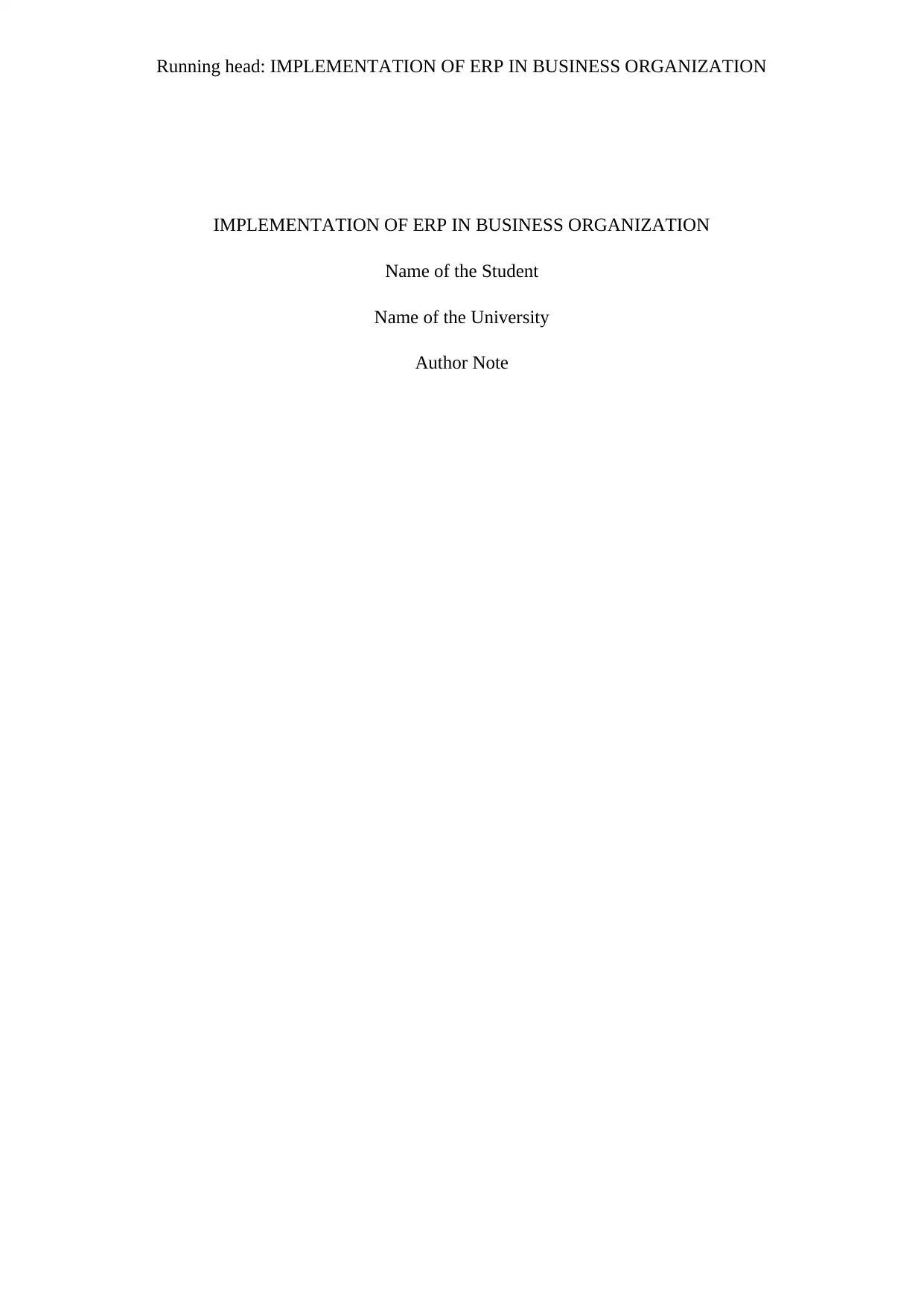
Running head: IMPLEMENTATION OF ERP IN BUSINESS ORGANIZATION
IMPLEMENTATION OF ERP IN BUSINESS ORGANIZATION
Name of the Student
Name of the University
Author Note
IMPLEMENTATION OF ERP IN BUSINESS ORGANIZATION
Name of the Student
Name of the University
Author Note
Paraphrase This Document
Need a fresh take? Get an instant paraphrase of this document with our AI Paraphraser
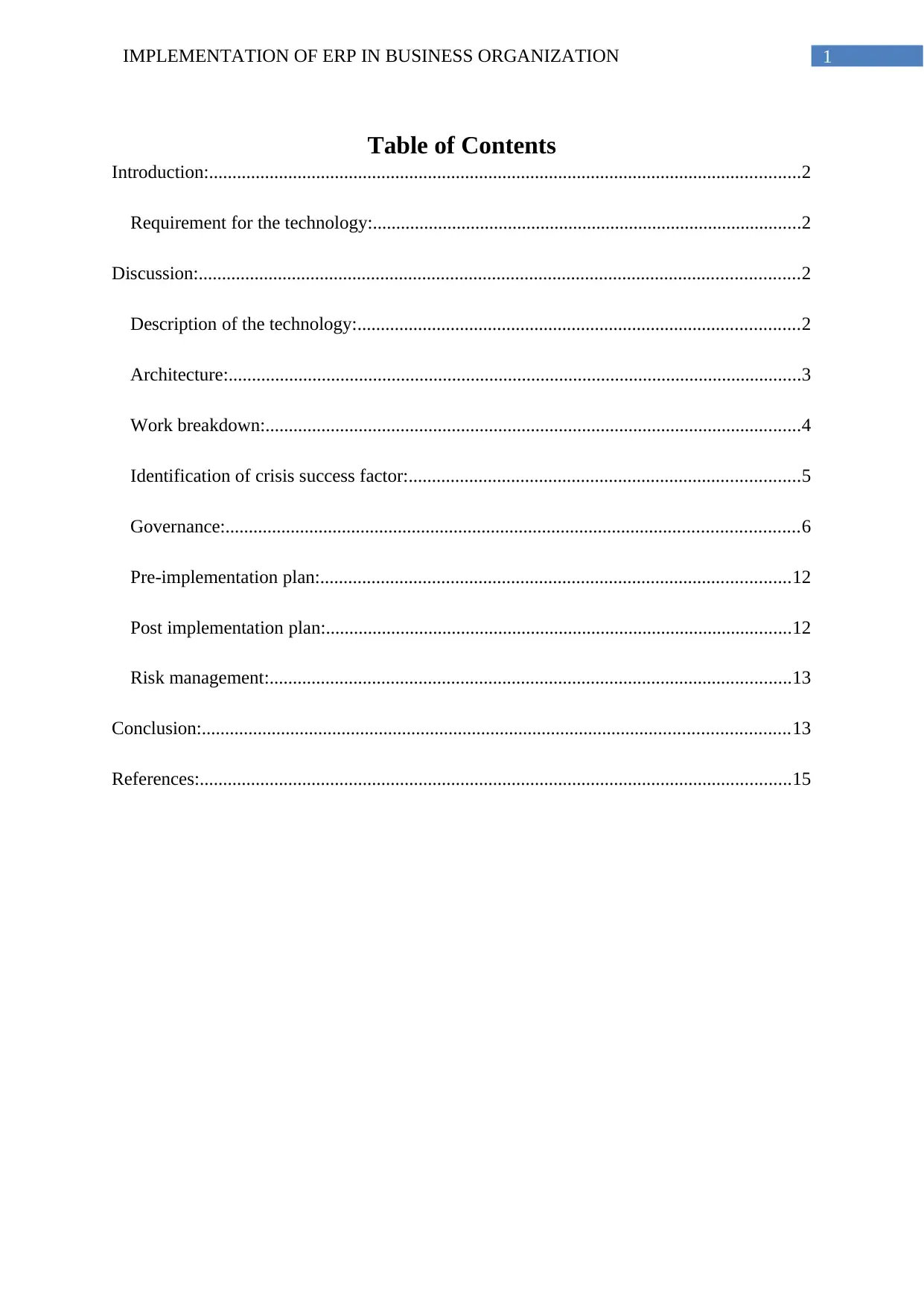
1IMPLEMENTATION OF ERP IN BUSINESS ORGANIZATION
Table of Contents
Introduction:...............................................................................................................................2
Requirement for the technology:............................................................................................2
Discussion:.................................................................................................................................2
Description of the technology:...............................................................................................2
Architecture:...........................................................................................................................3
Work breakdown:...................................................................................................................4
Identification of crisis success factor:....................................................................................5
Governance:...........................................................................................................................6
Pre-implementation plan:.....................................................................................................12
Post implementation plan:....................................................................................................12
Risk management:................................................................................................................13
Conclusion:..............................................................................................................................13
References:...............................................................................................................................15
Table of Contents
Introduction:...............................................................................................................................2
Requirement for the technology:............................................................................................2
Discussion:.................................................................................................................................2
Description of the technology:...............................................................................................2
Architecture:...........................................................................................................................3
Work breakdown:...................................................................................................................4
Identification of crisis success factor:....................................................................................5
Governance:...........................................................................................................................6
Pre-implementation plan:.....................................................................................................12
Post implementation plan:....................................................................................................12
Risk management:................................................................................................................13
Conclusion:..............................................................................................................................13
References:...............................................................................................................................15
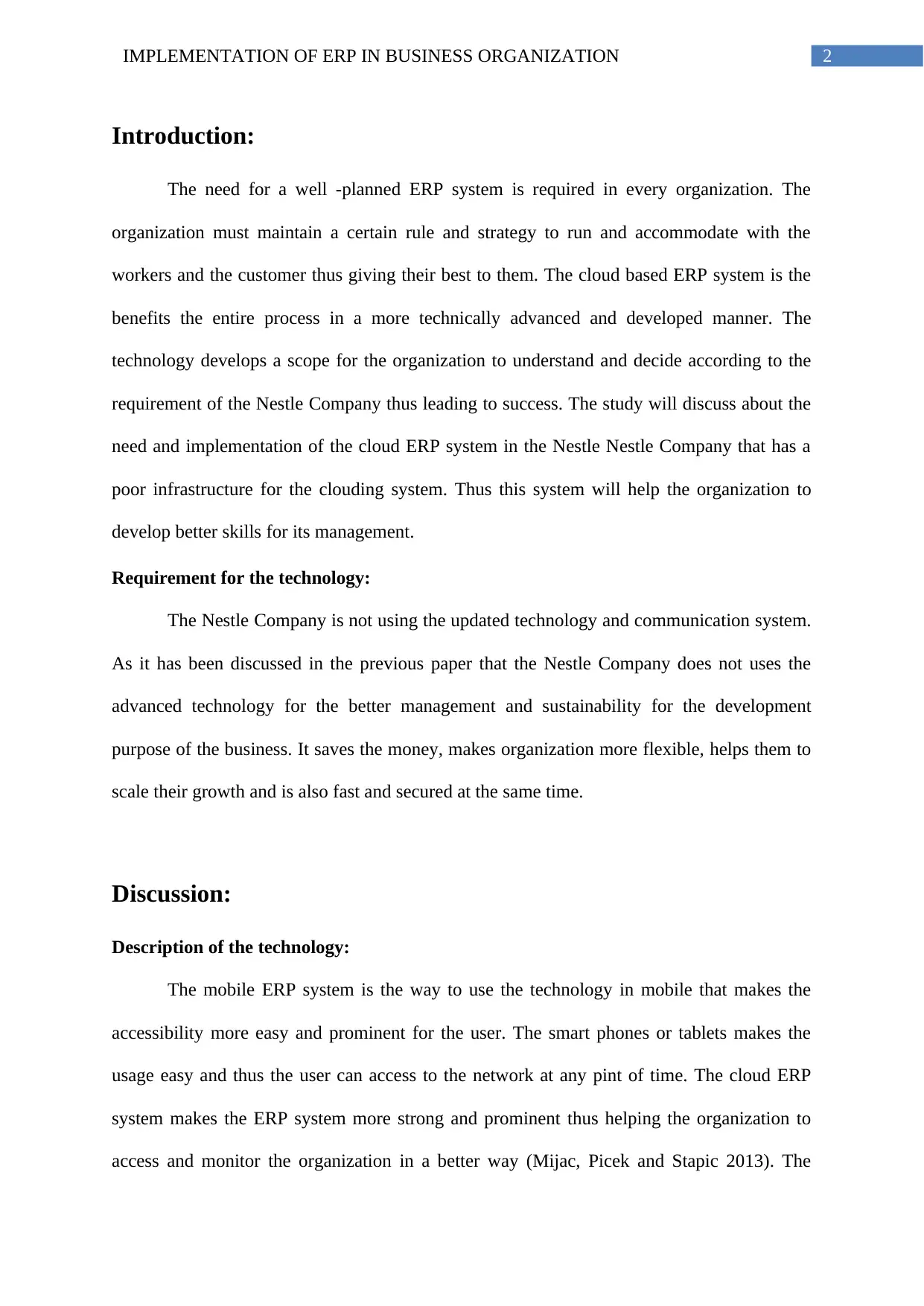
2IMPLEMENTATION OF ERP IN BUSINESS ORGANIZATION
Introduction:
The need for a well -planned ERP system is required in every organization. The
organization must maintain a certain rule and strategy to run and accommodate with the
workers and the customer thus giving their best to them. The cloud based ERP system is the
benefits the entire process in a more technically advanced and developed manner. The
technology develops a scope for the organization to understand and decide according to the
requirement of the Nestle Company thus leading to success. The study will discuss about the
need and implementation of the cloud ERP system in the Nestle Nestle Company that has a
poor infrastructure for the clouding system. Thus this system will help the organization to
develop better skills for its management.
Requirement for the technology:
The Nestle Company is not using the updated technology and communication system.
As it has been discussed in the previous paper that the Nestle Company does not uses the
advanced technology for the better management and sustainability for the development
purpose of the business. It saves the money, makes organization more flexible, helps them to
scale their growth and is also fast and secured at the same time.
Discussion:
Description of the technology:
The mobile ERP system is the way to use the technology in mobile that makes the
accessibility more easy and prominent for the user. The smart phones or tablets makes the
usage easy and thus the user can access to the network at any pint of time. The cloud ERP
system makes the ERP system more strong and prominent thus helping the organization to
access and monitor the organization in a better way (Mijac, Picek and Stapic 2013). The
Introduction:
The need for a well -planned ERP system is required in every organization. The
organization must maintain a certain rule and strategy to run and accommodate with the
workers and the customer thus giving their best to them. The cloud based ERP system is the
benefits the entire process in a more technically advanced and developed manner. The
technology develops a scope for the organization to understand and decide according to the
requirement of the Nestle Company thus leading to success. The study will discuss about the
need and implementation of the cloud ERP system in the Nestle Nestle Company that has a
poor infrastructure for the clouding system. Thus this system will help the organization to
develop better skills for its management.
Requirement for the technology:
The Nestle Company is not using the updated technology and communication system.
As it has been discussed in the previous paper that the Nestle Company does not uses the
advanced technology for the better management and sustainability for the development
purpose of the business. It saves the money, makes organization more flexible, helps them to
scale their growth and is also fast and secured at the same time.
Discussion:
Description of the technology:
The mobile ERP system is the way to use the technology in mobile that makes the
accessibility more easy and prominent for the user. The smart phones or tablets makes the
usage easy and thus the user can access to the network at any pint of time. The cloud ERP
system makes the ERP system more strong and prominent thus helping the organization to
access and monitor the organization in a better way (Mijac, Picek and Stapic 2013). The
⊘ This is a preview!⊘
Do you want full access?
Subscribe today to unlock all pages.

Trusted by 1+ million students worldwide

3IMPLEMENTATION OF ERP IN BUSINESS ORGANIZATION
Nestle Company was using the on-premise ERP system that did not provide the required
information to the Nestle Company (Developing 2013). The Nestle Company is expected to
develop better scope if they are using this technology in their ERP system.
Architecture:
The architecture of the ERP system has four major forms which their own advantages
and disadvantages in nature. The three tier architecture is a scale up of the two tier
architecture. It has three layers presentation, application and database layer. In this system the
client is not communicating with the database (Al-Ghofaili and Al-Mashari 2014). The
presentation layer is responsible for browsing information and providing the inter-phase that
helps the user to have powerful machines. The application layer is the place where the data is
retrieved and transferred to the database server. The business rules and logic are implemented
in this layer.
There is another architecture that is web based hat goals to allow the remote users to access
the ERP system. The application and the database layer is same for this system. The
presentation layer is split into two halves the wen service and the web browsers for
supporting the mobility of the device through internet (Salim 2013).
This system is not required in most of the organization but it will be required for his
organization. The Nestle Nestle Company is a huge organization that has to be accessed and
monitored not only in the organization premises but also after the closing of the office
premises. Thus a regular and daily checking of the system and work culture is must for the
organization. The Nestle Nestle Company requires ERP management from every resources
that includes the remote areas also, thus this type of architecture is highly required for the
organization. There are various type of architecture but among these the web-based
architecture can be used for this Nestle Company. Thus the architecture will help the
organization to run in an efficient and effective manner with its benefits.
Nestle Company was using the on-premise ERP system that did not provide the required
information to the Nestle Company (Developing 2013). The Nestle Company is expected to
develop better scope if they are using this technology in their ERP system.
Architecture:
The architecture of the ERP system has four major forms which their own advantages
and disadvantages in nature. The three tier architecture is a scale up of the two tier
architecture. It has three layers presentation, application and database layer. In this system the
client is not communicating with the database (Al-Ghofaili and Al-Mashari 2014). The
presentation layer is responsible for browsing information and providing the inter-phase that
helps the user to have powerful machines. The application layer is the place where the data is
retrieved and transferred to the database server. The business rules and logic are implemented
in this layer.
There is another architecture that is web based hat goals to allow the remote users to access
the ERP system. The application and the database layer is same for this system. The
presentation layer is split into two halves the wen service and the web browsers for
supporting the mobility of the device through internet (Salim 2013).
This system is not required in most of the organization but it will be required for his
organization. The Nestle Nestle Company is a huge organization that has to be accessed and
monitored not only in the organization premises but also after the closing of the office
premises. Thus a regular and daily checking of the system and work culture is must for the
organization. The Nestle Nestle Company requires ERP management from every resources
that includes the remote areas also, thus this type of architecture is highly required for the
organization. There are various type of architecture but among these the web-based
architecture can be used for this Nestle Company. Thus the architecture will help the
organization to run in an efficient and effective manner with its benefits.
Paraphrase This Document
Need a fresh take? Get an instant paraphrase of this document with our AI Paraphraser
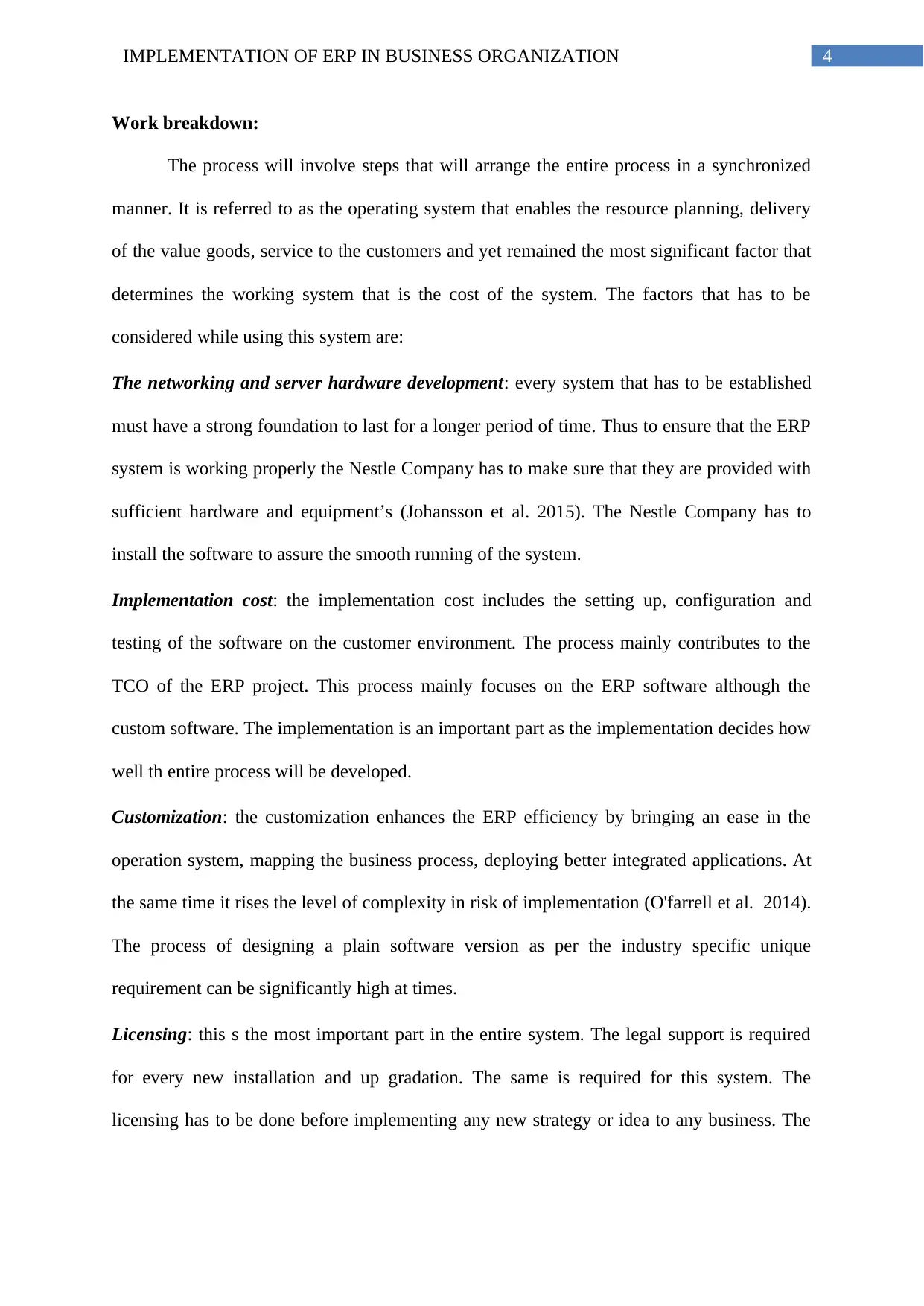
4IMPLEMENTATION OF ERP IN BUSINESS ORGANIZATION
Work breakdown:
The process will involve steps that will arrange the entire process in a synchronized
manner. It is referred to as the operating system that enables the resource planning, delivery
of the value goods, service to the customers and yet remained the most significant factor that
determines the working system that is the cost of the system. The factors that has to be
considered while using this system are:
The networking and server hardware development: every system that has to be established
must have a strong foundation to last for a longer period of time. Thus to ensure that the ERP
system is working properly the Nestle Company has to make sure that they are provided with
sufficient hardware and equipment’s (Johansson et al. 2015). The Nestle Company has to
install the software to assure the smooth running of the system.
Implementation cost: the implementation cost includes the setting up, configuration and
testing of the software on the customer environment. The process mainly contributes to the
TCO of the ERP project. This process mainly focuses on the ERP software although the
custom software. The implementation is an important part as the implementation decides how
well th entire process will be developed.
Customization: the customization enhances the ERP efficiency by bringing an ease in the
operation system, mapping the business process, deploying better integrated applications. At
the same time it rises the level of complexity in risk of implementation (O'farrell et al. 2014).
The process of designing a plain software version as per the industry specific unique
requirement can be significantly high at times.
Licensing: this s the most important part in the entire system. The legal support is required
for every new installation and up gradation. The same is required for this system. The
licensing has to be done before implementing any new strategy or idea to any business. The
Work breakdown:
The process will involve steps that will arrange the entire process in a synchronized
manner. It is referred to as the operating system that enables the resource planning, delivery
of the value goods, service to the customers and yet remained the most significant factor that
determines the working system that is the cost of the system. The factors that has to be
considered while using this system are:
The networking and server hardware development: every system that has to be established
must have a strong foundation to last for a longer period of time. Thus to ensure that the ERP
system is working properly the Nestle Company has to make sure that they are provided with
sufficient hardware and equipment’s (Johansson et al. 2015). The Nestle Company has to
install the software to assure the smooth running of the system.
Implementation cost: the implementation cost includes the setting up, configuration and
testing of the software on the customer environment. The process mainly contributes to the
TCO of the ERP project. This process mainly focuses on the ERP software although the
custom software. The implementation is an important part as the implementation decides how
well th entire process will be developed.
Customization: the customization enhances the ERP efficiency by bringing an ease in the
operation system, mapping the business process, deploying better integrated applications. At
the same time it rises the level of complexity in risk of implementation (O'farrell et al. 2014).
The process of designing a plain software version as per the industry specific unique
requirement can be significantly high at times.
Licensing: this s the most important part in the entire system. The legal support is required
for every new installation and up gradation. The same is required for this system. The
licensing has to be done before implementing any new strategy or idea to any business. The
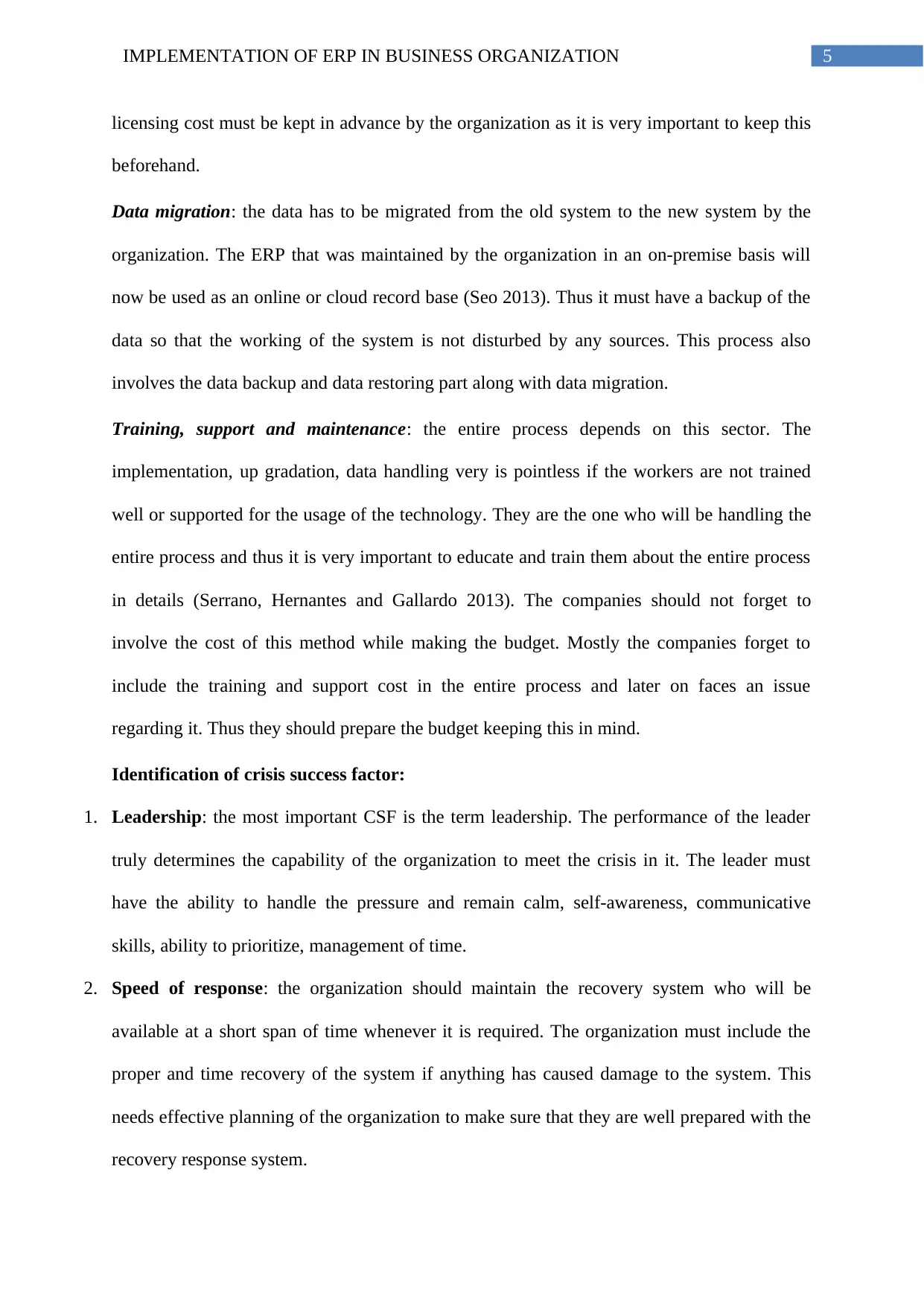
5IMPLEMENTATION OF ERP IN BUSINESS ORGANIZATION
licensing cost must be kept in advance by the organization as it is very important to keep this
beforehand.
Data migration: the data has to be migrated from the old system to the new system by the
organization. The ERP that was maintained by the organization in an on-premise basis will
now be used as an online or cloud record base (Seo 2013). Thus it must have a backup of the
data so that the working of the system is not disturbed by any sources. This process also
involves the data backup and data restoring part along with data migration.
Training, support and maintenance: the entire process depends on this sector. The
implementation, up gradation, data handling very is pointless if the workers are not trained
well or supported for the usage of the technology. They are the one who will be handling the
entire process and thus it is very important to educate and train them about the entire process
in details (Serrano, Hernantes and Gallardo 2013). The companies should not forget to
involve the cost of this method while making the budget. Mostly the companies forget to
include the training and support cost in the entire process and later on faces an issue
regarding it. Thus they should prepare the budget keeping this in mind.
Identification of crisis success factor:
1. Leadership: the most important CSF is the term leadership. The performance of the leader
truly determines the capability of the organization to meet the crisis in it. The leader must
have the ability to handle the pressure and remain calm, self-awareness, communicative
skills, ability to prioritize, management of time.
2. Speed of response: the organization should maintain the recovery system who will be
available at a short span of time whenever it is required. The organization must include the
proper and time recovery of the system if anything has caused damage to the system. This
needs effective planning of the organization to make sure that they are well prepared with the
recovery response system.
licensing cost must be kept in advance by the organization as it is very important to keep this
beforehand.
Data migration: the data has to be migrated from the old system to the new system by the
organization. The ERP that was maintained by the organization in an on-premise basis will
now be used as an online or cloud record base (Seo 2013). Thus it must have a backup of the
data so that the working of the system is not disturbed by any sources. This process also
involves the data backup and data restoring part along with data migration.
Training, support and maintenance: the entire process depends on this sector. The
implementation, up gradation, data handling very is pointless if the workers are not trained
well or supported for the usage of the technology. They are the one who will be handling the
entire process and thus it is very important to educate and train them about the entire process
in details (Serrano, Hernantes and Gallardo 2013). The companies should not forget to
involve the cost of this method while making the budget. Mostly the companies forget to
include the training and support cost in the entire process and later on faces an issue
regarding it. Thus they should prepare the budget keeping this in mind.
Identification of crisis success factor:
1. Leadership: the most important CSF is the term leadership. The performance of the leader
truly determines the capability of the organization to meet the crisis in it. The leader must
have the ability to handle the pressure and remain calm, self-awareness, communicative
skills, ability to prioritize, management of time.
2. Speed of response: the organization should maintain the recovery system who will be
available at a short span of time whenever it is required. The organization must include the
proper and time recovery of the system if anything has caused damage to the system. This
needs effective planning of the organization to make sure that they are well prepared with the
recovery response system.
⊘ This is a preview!⊘
Do you want full access?
Subscribe today to unlock all pages.

Trusted by 1+ million students worldwide

6IMPLEMENTATION OF ERP IN BUSINESS ORGANIZATION
3. A robust plan: the plan should be already made before the scope of emergency arrives. The
organization should assure that they have already made a plan that is helping them to meet
the criteria for the recovery or meeting the challenges that might be faced by the system.
4. Adequate resources: the organization must have enough resources for meeting any crisis
period that are possible for the Nestle Company to meet. The crisis generally occurs in a most
weird and inconvenient times. Thus it is important for the Nestle Company to stay prepared
so that they do not face any challenge or even if they face they can meet it in a proper
manner.
5. Caring and compassionate response: the organization should make sure that they are
managing the entire system in a well framed manner, starting from the management to9 the
customer satisfaction part. The Nestle Company should make sure that the teams are
communicating with the people in an effective manner so that at adverse times also the
customers are supporting the Nestle Company.
Thus if the Nestle Company is identifying such crisis management strategies then there
are high chances that even when the process is not working initially for the Nestle Company
then these aspects will help the Nestle Company to survive.
Governance:
Cost and budget:
Startup Expenses
Buildings / Real Estate
Purchase
$
55,000
Construction
3. A robust plan: the plan should be already made before the scope of emergency arrives. The
organization should assure that they have already made a plan that is helping them to meet
the criteria for the recovery or meeting the challenges that might be faced by the system.
4. Adequate resources: the organization must have enough resources for meeting any crisis
period that are possible for the Nestle Company to meet. The crisis generally occurs in a most
weird and inconvenient times. Thus it is important for the Nestle Company to stay prepared
so that they do not face any challenge or even if they face they can meet it in a proper
manner.
5. Caring and compassionate response: the organization should make sure that they are
managing the entire system in a well framed manner, starting from the management to9 the
customer satisfaction part. The Nestle Company should make sure that the teams are
communicating with the people in an effective manner so that at adverse times also the
customers are supporting the Nestle Company.
Thus if the Nestle Company is identifying such crisis management strategies then there
are high chances that even when the process is not working initially for the Nestle Company
then these aspects will help the Nestle Company to survive.
Governance:
Cost and budget:
Startup Expenses
Buildings / Real Estate
Purchase
$
55,000
Construction
Paraphrase This Document
Need a fresh take? Get an instant paraphrase of this document with our AI Paraphraser
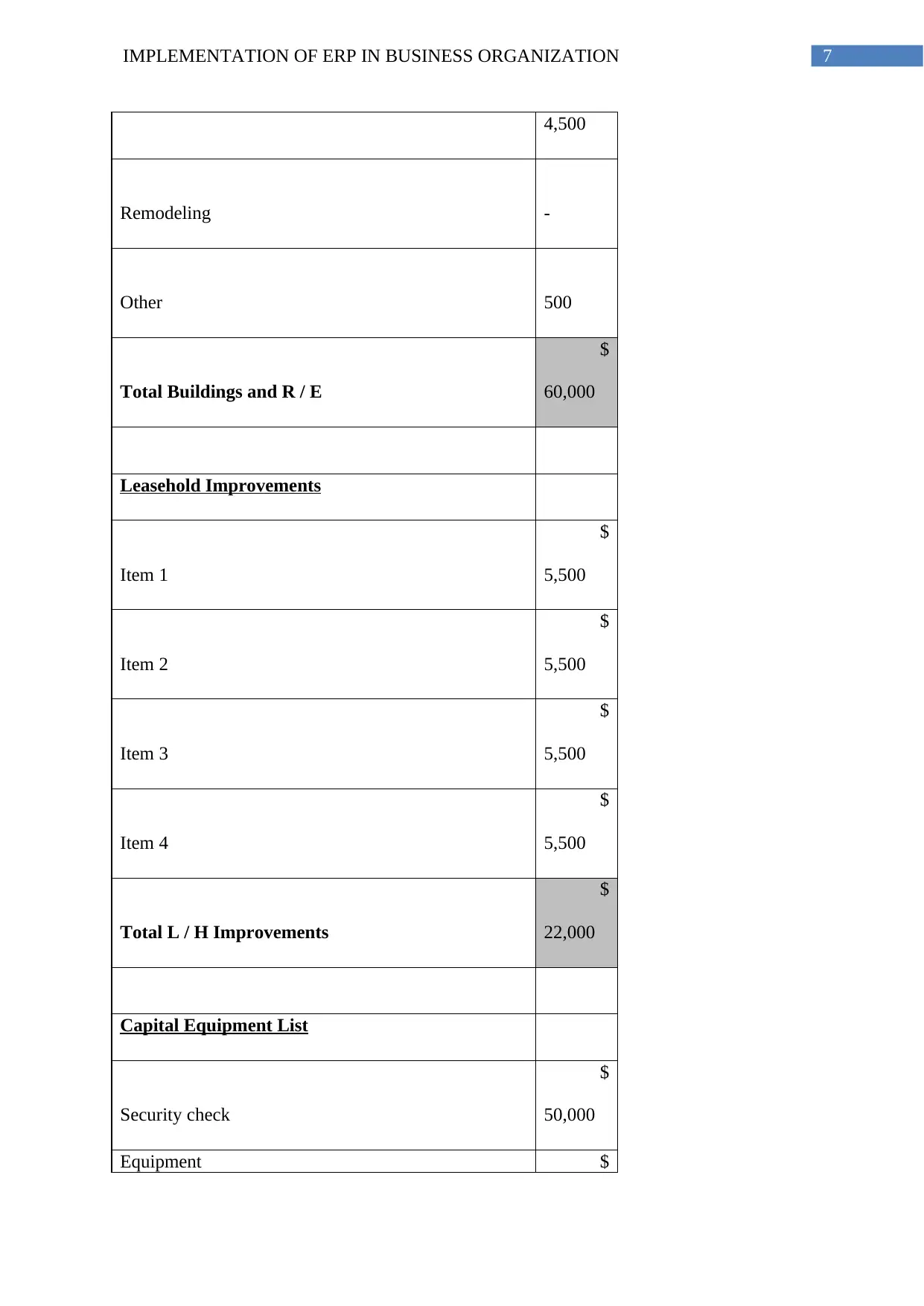
7IMPLEMENTATION OF ERP IN BUSINESS ORGANIZATION
4,500
Remodeling -
Other 500
Total Buildings and R / E
$
60,000
Leasehold Improvements
Item 1
$
5,500
Item 2
$
5,500
Item 3
$
5,500
Item 4
$
5,500
Total L / H Improvements
$
22,000
Capital Equipment List
Security check
$
50,000
Equipment $
4,500
Remodeling -
Other 500
Total Buildings and R / E
$
60,000
Leasehold Improvements
Item 1
$
5,500
Item 2
$
5,500
Item 3
$
5,500
Item 4
$
5,500
Total L / H Improvements
$
22,000
Capital Equipment List
Security check
$
50,000
Equipment $
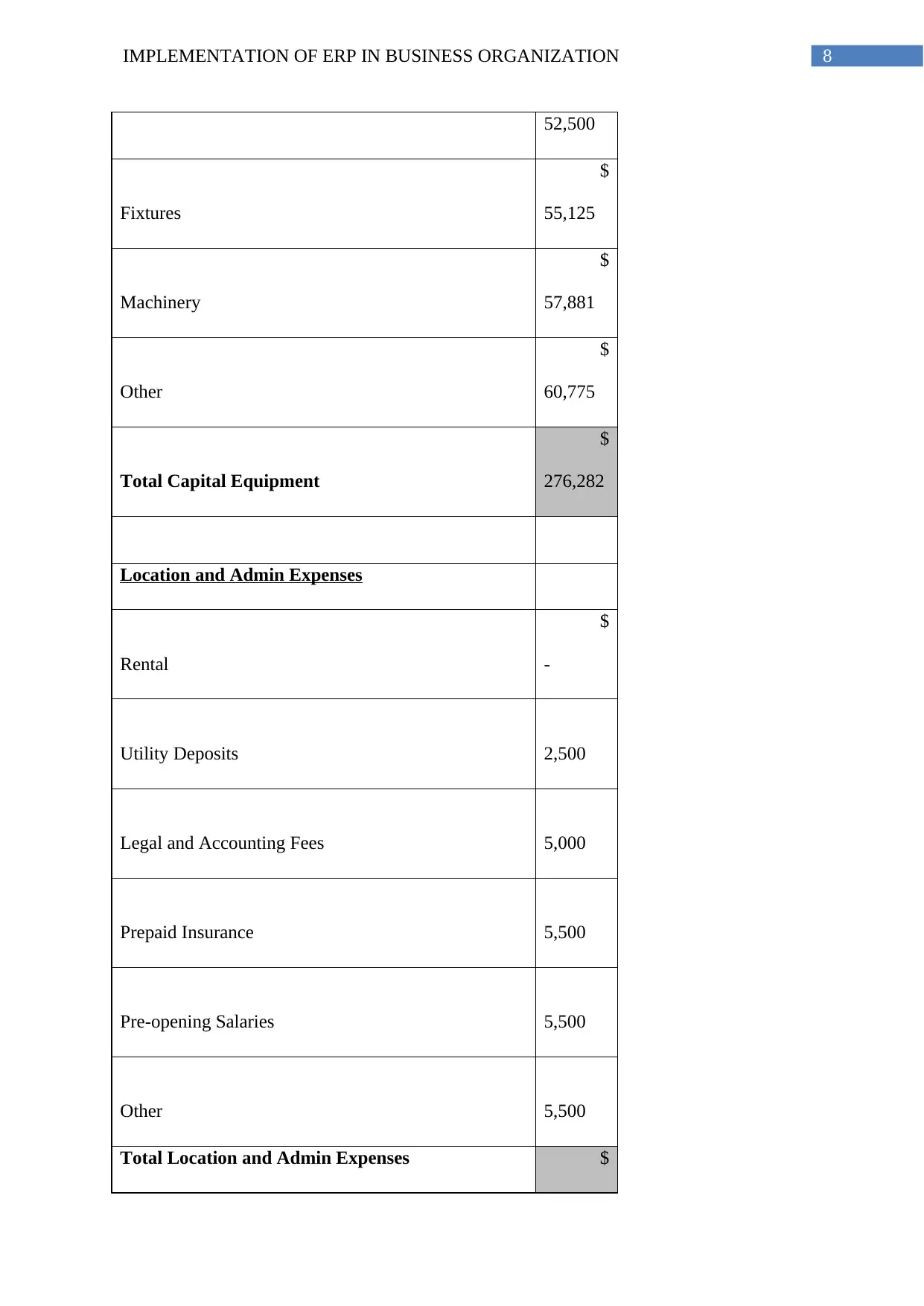
8IMPLEMENTATION OF ERP IN BUSINESS ORGANIZATION
52,500
Fixtures
$
55,125
Machinery
$
57,881
Other
$
60,775
Total Capital Equipment
$
276,282
Location and Admin Expenses
Rental
$
-
Utility Deposits 2,500
Legal and Accounting Fees 5,000
Prepaid Insurance 5,500
Pre-opening Salaries 5,500
Other 5,500
Total Location and Admin Expenses $
52,500
Fixtures
$
55,125
Machinery
$
57,881
Other
$
60,775
Total Capital Equipment
$
276,282
Location and Admin Expenses
Rental
$
-
Utility Deposits 2,500
Legal and Accounting Fees 5,000
Prepaid Insurance 5,500
Pre-opening Salaries 5,500
Other 5,500
Total Location and Admin Expenses $
⊘ This is a preview!⊘
Do you want full access?
Subscribe today to unlock all pages.

Trusted by 1+ million students worldwide

9IMPLEMENTATION OF ERP IN BUSINESS ORGANIZATION
24,000
Opening Inventory
Category 1
$
1,250
Category 2
$
1,250
Category 3
$
1,250
Category 4
$
1,250
Category 5
$
1,250
Total Inventory
$
6,250
Advertising and Promotional Expenses
Advertising
$
1,250
Signage
$
1,312.50
Printing
$
1,378.13
Travel & Entertainment $
24,000
Opening Inventory
Category 1
$
1,250
Category 2
$
1,250
Category 3
$
1,250
Category 4
$
1,250
Category 5
$
1,250
Total Inventory
$
6,250
Advertising and Promotional Expenses
Advertising
$
1,250
Signage
$
1,312.50
Printing
$
1,378.13
Travel & Entertainment $
Paraphrase This Document
Need a fresh take? Get an instant paraphrase of this document with our AI Paraphraser

10IMPLEMENTATION OF ERP IN BUSINESS ORGANIZATION
1,447.03
Other / Additional categories
$
1,519.38
Total Adv and Promo expenses
$
6,907
Payroll and payroll taxes
Expense 1
$
25,000
Expense 2 25,000
Total Payroll and payroll taxes
$
50,000
Summary Statement
Sources of Capital
Owners' and Other Investments
$
6,027,500
Bank Loans
5,
000
Other Loans 90,
1,447.03
Other / Additional categories
$
1,519.38
Total Adv and Promo expenses
$
6,907
Payroll and payroll taxes
Expense 1
$
25,000
Expense 2 25,000
Total Payroll and payroll taxes
$
50,000
Summary Statement
Sources of Capital
Owners' and Other Investments
$
6,027,500
Bank Loans
5,
000
Other Loans 90,

11IMPLEMENTATION OF ERP IN BUSINESS ORGANIZATION
000
Total Source of Funds
$
6,122,500
Startup Expenses
Bldgs / Real Estate
$
60,000
Leasehold Improvements
22,
000
Capital Equipment
276,
282
Location / Admin Expenses
24,
000
Opening Inventory -
Advertising / Promo Expenses
6,
907
Other Expenses
50,
000
Total Startup Expenses
$
12,684,189
000
Total Source of Funds
$
6,122,500
Startup Expenses
Bldgs / Real Estate
$
60,000
Leasehold Improvements
22,
000
Capital Equipment
276,
282
Location / Admin Expenses
24,
000
Opening Inventory -
Advertising / Promo Expenses
6,
907
Other Expenses
50,
000
Total Startup Expenses
$
12,684,189
⊘ This is a preview!⊘
Do you want full access?
Subscribe today to unlock all pages.

Trusted by 1+ million students worldwide
1 out of 14
Related Documents
Your All-in-One AI-Powered Toolkit for Academic Success.
+13062052269
info@desklib.com
Available 24*7 on WhatsApp / Email
![[object Object]](/_next/static/media/star-bottom.7253800d.svg)
Unlock your academic potential
Copyright © 2020–2025 A2Z Services. All Rights Reserved. Developed and managed by ZUCOL.




